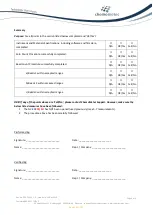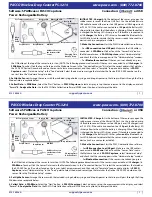
ChemoMetec® Test Kits
ChemoMetec A/S
Document no. 995-0072
Edition No. 1.2
Day of issue: 10 February 2020
Page 3 of 4
SECTION 10: Stability and reactivity
10.1. Reactivity:
No available data.
10.2. Chemical stability:
Stable under the recommended storage conditions - see section 7.
10.3. Possibility of hazardous reactions:
None known.
10.4. Conditions to avoid:
Excessive heating and direct sunlight.
10.5. Incompatible materials:
Strong oxidizing agents, reducing agents, strong acids and bases, heavy metals and salts. Sodium azide forms a very toxic gas
(hydrogen azide) in contact with acids. Sodium azide may react with lead and copper, to form explosive metalazides.
10.6. Hazardous decomposition products:
When heated to high temperatures (decomposition) toxic gasses are formed such as oxides of nitrogen, sodium and carbon,
hydrogen chloride and phosgene.
SECTION 11: Toxicological information
11.1. Information on toxicological effects:
Hazard class
Data
(Sodium azide)
Test
Data source
Acute toxicity:
Inhalation
LC
50
(rat) = 37 mg/m
3
No info
RTECS
Dermal
LD
50
(rabbit) = 20 mg/kg
No info
RTECS
Oral
LD
Lo
(woman) = 14 mg/kg
LD
50
(rat) = 27 mg/kg
No info
No info
RTECS
RTECS
Corrosion/irritation: No irritation, skin and eyes
No info
ECHA
Sensitization:
No skin sensitization, guinea pig
OECD 419
ECHA
CMR:
TD
Lo
= 2730 mg/kg/78W (rat, continuous) “Equivocal
tumorigenic agent”
TD
Lo
= 177.5 mg/kg (rat, 6-19 days after birth): “Effects on
embryo or foetus”.
No info
No info
RTECS
RTECS
Information on likely routes of exposure: Lungs, skin and ingestion.
Symptoms:
Inhalation:
Vapours may cause irritation to the airways.
Skin:
May cause irritation by prolonged contact with skin.
Eyes:
May cause eye irritation.
Ingestion:
May cause irritation of the gastrointestinal tract, nausea, vomiting and headache.
Chronic effects:
Sodium azide in its pure form does affect the CNS, is a possible mutagen and have caused carcinogenic
effect in rats. No conclusive data for humans.
SECTION 12: Ecological information
12.1. Toxicity:
Aquatic
Data
(Sodium azide)
Test (Media)
Data source
Fish
LC
50
(Lepomis macrochirus, 96h) = 0.7 mg/l
No info
ECHA
Daphnia
EC
50
(Daphnia pulex, 48h) = 4.2 mg/l
No info
ECHA
Algae
EC
50
(Pseudokirchneriella sub. 96h) = 0.35 mg/l
No info
ECHA
12.2. Persistence and degradability:
Sodium azide is an inorganic substance, methods for the determination of the biological degradation is not applicable to
inorganic substances
12.3. Bioaccumulative potential:
Sodium azide: Log K
ow
< 1 – No bioaccumulative potential.
12.4. Mobility in soil:
No available/applicable data
12.5. Results of PBT and vPvB assessment:
No ingredients are PBT/vPvB, according to the criteria in REACH Annex XIII.
12.6. Other adverse effects:
None known
Page 42 of 127
Summary of Contents for NucleoCounter NC-202
Page 1: ...997 0005 NucleoCounter NC 202 Document Compilation V 1 0 Page 1 of 127...
Page 14: ...Page 14 of 127...
Page 15: ...Page 15 of 127...
Page 16: ...Page 16 of 127...
















































